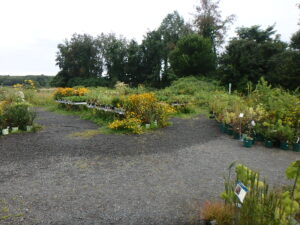Starting Wildflowers from Seed
Posted on Tuesday, August 24, 2021 · Leave a Comment
I recently visited the Nasami Farm in Whately, MA. This is the plant production facility for the Native Plants Trust, formerly the New England Wildflower Society. I met with Alexis Doshas, their nursery manager. The 75–acre farm produces perennials, grasses and some woody plants – mainly from seed. The plants are sold at their headquarters in Framingham, MA, and at the Nasami Farm on weekends.

Nasami Farm produces many species of wildflower trees and shrubs from seeds
If you are interested in growing wildflowers, the least expensive way to get plenty is to start them from seed. This takes some effort, but it accomplishes a number of things: if you collect seed from the wild, you are getting plants in your garden without diminishing the wild population – the way you would if you dug plants (which is prohibited anyway in most places).
Starting plants from seed also encourages genetic diversity. Many purchased plants are propagated from cuttings or by division, which means they are all clones with the exact same genes. Seeds from any given plant produce seedlings with a wide range of characteristics, making some less susceptible to environmental challenges such as global warming.

Remove the fuzzy bits to separate seeds before planting
Starting wildflowers from seed can take patience. While some seeds will germinate and grow the same summer you collect them (Campanulas, for example), other things like lilies might take 4 or 5 years to bloom. Many require a cold period of 3 months, which is called cold stratification. Some planted now will grow underground next spring, but not send up any green growth until the following spring.
The Nasami Farm grows seedlings in big plastic hoop houses. These are not heated except in spring, or if temperatures go below zero in winter. The greenhouses allow the seedlings to be monitored and tended easily on long tables. You could set up a table in your barn, shed or garage for a few flats of seedlings. Some wildflowers will do fine in flats with good drainage in the outdoors – preferably in a shady place that won’t see too much of the hot, drying sun.

Flats of wildflowers at Nasami Farm
Lastly, you can plant seeds directly in the ground in a site where they will thrive as mature plants. The disadvantage to this is that you never know what percentage of seeds will germinate. If you plant 100 seeds in a flat indoors it will be easier to thin or transplant the seedlings than if you must do so on your hands and knees. And there should be no weed competition if you are using a germination mix in a flat. On the other hand, I plant things like golden seal directly in the ground as it takes 2 years to sprout, and I don’t want to have to water and tend them so long.
Alexis Doshas gave me some tips for success when starting wildflowers from seed. First, she said, collect seed when it is easy to pull off the plant, and remove any fluffy stuff attached to it. Generally seeds start light colored, and darken when fully ripe. If you want to store seed, make sure it doesn’t dry out. Store in a cool, dark place.
Buy a very fine seed germination mix, something made of finely ground peat and perlite. A coarse mix can let seeds wash down deeper than they should be. For small seeds (the size of a grain of sand or less) just sow seeds, pat them into the soil mix and water them in. No need to cover them. Alexis suggests germinating seeds at 60 to 80 degrees, but also cautioned that many wildflowers need a 90-day cold period before they will grow.
Alexis said you may need to provide rodent protection: metal hardware cloth over the flats to keep mice from eating the seeds. Rodents can be a problem as easily in your cold basement as in a barn or outdoors.
I asked Alexis to recommend some plants that would be easy to start from seed right now. She suggested blueberries, huckleberries and plums for fruits. Of the flowers, she listed these: milkweed, mountain mint, black-eyed Susans, wild bee balm, wild iris, asters, Joe Pye weed and all the goldenrods, which are great for pollinators.
Woodland wildflowers, she said, often have very specific needs and are not as easy to grow as the field flowers mentioned above. Soil pH and type are important. When I plant spring wildflowers I try to mimic the forest type of their native habitat: if they grow in a maple-beech-ash forest in the wild, I try to plant them in a similar environment.

Golden seal fruits are ready for picking in my woods right now
Plants with large, fleshy fruits such as Jack-in-the pulpit or golden seal probably will require you to remove the fruit portion before planting. Gloves are suggested, as some have strong chemicals that may irritate your skin. You can soak seeds like that to allow fermentation to remove the skin and flesh.
A good reference text for anyone interested in starting wildflower seeds is by William Cullina, Growing and Propagating Wildflowers of the United States and Canada. Unfortunately, it is out of print, though I’ve heard it is in the process of being reprinted. It is worth its weight in gold as it gives specifics for each of hundreds of wildflowers.
So try collecting some seeds, and schedule a visit to Nasami Farm or the Garden in the Woods.
Henry is the author of 4
gardening books. He lives and writes in Cornish Flat, NH. His web site ids
www.Gardening-guy.com.






